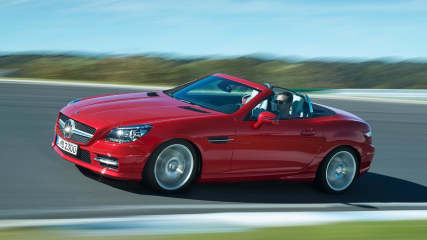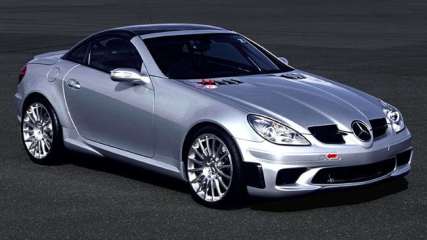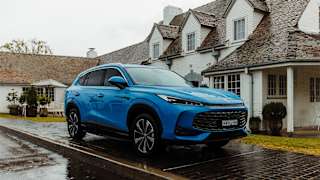Mercedes-Benz SLK-Class 2005 Review
By Staff Writers · 22 Jan 2005
The compact droptop is the hottest item on the Mercedes menu in 2005, and the McLaren men usually get what they want when it's Grand Prix time.Also, there is a little hint of Formula One about the all-new Mercedes SLK.Squint when you look at the nose and you see how the drooping bonnet and road-sniffer snout were inspired by the McLaren-Mercedes grand prix cars.It also gives the SLK a visual link to the king-of-the-hill Mercedes-McLaren SLR. Most people would be hard-pressed to pick them apart in a 100m taste test – provided, of course, that Lindsay Fox brings Australia's only SLR back from Europe.But back to the SLK, which has become a sellout in Australia, with a waiting list that rolls back as faras demand for the demonic SL 55 AMG.Benz sold 350 cars in the second half of 2004 and is expecting solid demand through 2005 for a car that is bigger, bolder, brighter and much more refined than the first model to wear the SLK badge through the mid-1990s.Pricing starts at $86,900 for the SLK 200K, which is a lot for a Commodore shopper but a relative bargain for someone searching for something special in the prestige class. It also runs it up comfortably against rivals including the Audi TT Roadster and the Chrysler Crossfire droptop, which looks good but uses the mechanical package from the previous-generation SLK.The basics of the new SLK are the same, with a two-seat cabin and a folding metal roof, but Mercedes engineers went right down to the road to revamp the car for the noughties.They were working inside a bigger envelope, because the car is now 72mm longer and 65mm wider. It is space that's been put into the cabin, giving more room in every direction.Fine tuning includes a computer screen in the centre of the dashboard, Mercedes' latest seven-speed auto gearbox and an engine choice that runs from a supercharged four to a revamped V6, up to the stonking V8 that's fitted to the pocket rocket SLK 55 AMG.The initial focus for the new-age SLK has been on the 350 model, priced at $112,900. It has the latest four-valve V6, with variable valve timing and movable flaps in the intake system to release 200kW of power, and 350Nm of torque in a broad sweep from 2400 through to 5000 revs.The SLK comes standard with a seven-speed automatic gearbox, but Benz is also pushing harder with the six-speed manual, a saving of $3500, after working to improve the shift feel.There are all sorts of other changes, from reshaped seats and new-look switches to a tougher-looking plastic panelling for the dash and console to make it more usable in top-down conditions.ON THE ROADTHE SLK 350 is a terrific car. It looks good, drives very well and is nicely priced for the people who will be shopping in the Benz district for their next car.We enjoyed the extra space in the cabin, the extra stiffness in the body and the improved driving experience. The original SLK was a fairly dull and uninspired drive, but Benz has done a good job in tweaking the little two- seater without turning it into a car you have to drive all the time, like the BMW Z4 or Nissan's 350Z roadster. It is still comfy for cruising and that's a big bonus.But we cannot say the same for the six-speed manual gearbox in the test car. Benz says it is a lot better than earlier manuals, but that's not much of a plug from a company that sells almost exclusively automatics – even to its sports-focused AMG owners.We found the change was slow, and needed the clutch right on the floor for a significant pause to avoid baulking. It might save $3500, but the manual also has worse fuel consumption and a slower 0-100km/h time than the automatic.It's a pity because the latest V6 is a honey. It has a creamy surge of acceleration from less than 2000 revs, but gets barking from 3500 and is keen to rev right to the redline (most un-Benz). It means the car has the punch to back its looks and won't be embarrassed at the traffic lights, or in a tight overtaking sprint.The engine also makes curvy roads into fun runs, particularly with the sharper feel in the steering. We tried a seven-speeder briefly during our SLK time, and would definitely pick it over the manual, and not because it has nifty shift buttons on the steering wheel.We could feel the extra rigidity in the new SLK and, perhaps surprisingly, it was better with the top down.The roof itself is as terrific as always, the headlights are good, there is pretty good luggage space and the car is easy to park. It also did pretty well on fuel at 13.2 litres/100km, sipping less than nine litres on the highway. But we didn't like the new plastic trim, which gets dirty easily, and the outside temperature gauge in the test car often went crazy and spun around to 44.5C on a top-up 18C day. So the Benz isn't perfect.THE BOTTOM LINEThe update has made the SLK a sportier drive, and even more of a head-turner.








